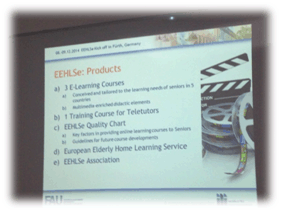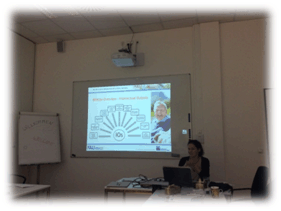

EHLSSA 2014-1-DE02-KA204-001664
• Programme: Erasmus+ 2014
• Durée du projet : 01.09.2014 – 31.08.2017
•
Partenaires:
1)
ILI, Innovation in Learning Institute (Germany)
2)
ESE, E-Seniors (France)
3)
DCU, Dublin City University (Ireland)
4)
UJI, Universidad Jaume I de Castellon
(Spain)
5)
Helsingin Yliopisto
(Finland)
•
Objectifs :
1)
Mise en place d'une infrastructure d'apprentissage pour les personnes âgées
en Europe
2) Programme de formation pour les personnes âgées et pour les
formateurs
3) Dans 5 pays et dans 5 langues
4) Utilisation compétente et autonome des TICs
·
Public cible :
Toutes les personnes âgées de l‘Europe
- Avec un accès d‘Internet
- Avec les compétences de base d‘Internet
•
Réunions des partenaires :
1)
Première Réunion Transnationale: 8 – 9 dé
cembre 2014 à Furth
2)
Seconde
Réunion Transnationale l: 11 – 12 -
13 mai 2014 à Castellon
3)
3ème
Réunion Transnationale : 14 – 15 – 16 septembre 2015 à Dublin
4)
4ème Réunion Transnationale : 7 – 8 – 9 mars 2016 à Helsinki
5)
5ème
Réunion Transnationale: automne 2016 à
Furth
6)
Conférence finale : printemps 2017
à Paris
•
Résultats:
Ce projet
a pour résultat principal de mettre en place l’Association Européenne
du Service de l’Apprentissage à Domicile avec tous ses composants.
Il s’agit de valider l'approche choisie et de fixer la base de l'infrastructure
d'apprentissage pour les personnes âgées en Europe. Tous les
éléments doivent être optimisés en évaluant
la formation tout au long du projet. Si le prototype fonctionne correctement,
une deuxième phase du projet est prévue : ajouter d'autres pays
européens et proposer une offre de cours plus complète.
·
Description du projet


The European Elderly Home Learning Service
( EEHLSe) proposal is based on the widely accepted and reported Europe-wide
analysis about (missing) learning opportunities for elderly and its
consequences. However, all steps to overcome this undesirable situation can
clearly be derived by logic and empirical evidence.
Two elements will assist us in analyzing
the situation. The first element has to do with the fact that European elderly
are, in their majority, excluded from continuous learning. Whilst all other citizens,
starting from the age of one year, have a guaranteed life accompanying
education and training offer, the after retirement population does not have
this opportunity. All reliable offers end at a time where people have, in
average, another 20 or 30 years of life. This is known a well-known fact in
Europe and it has been discussed widely for many years but no solution has been
found so far. This proposal claims to enter a new phase of elderly (online)
learning and pave the way for overcoming this entirely unsatisfying current
situation.
The second element of analysis concerns
the opportunity for learning of the elderly. It is evident that, in a rapidly
changing world, life without learning leads to unpleasant effects both for the
individual and for the society. Some of these effects are: reduced autonomy,
increasing dependency from others, less integration, social isolation,
segregation of generations, reduced satisfaction of life, more fragile health…
Every reported effect on one hand could be underlined with empirical data,on
the other hand is selfevident.
We will, in the following, compile all
elements which are needed for our high level aspiration, to provide in
principle every elderly in Europe, independent of her/his geographical
situation, mobility, availability of time and daily rhythm, with a reliable
learning offer within ten years’ time. EEHLSe will model and empirically
validate this ambitious promise.
Before entering into the details of the
proposal we have to clarify why eLearning is an appropriate learning method for
the elderly.
There are many good reasons:
- In eLearning, learning comes to the
learners. This is extremely important in remote situations or situations of
handicap or of care.
- Elderly are very heterogeneous
–individual preconditions can much better be taken into consideration.
- Learning path and pace can be
individually chosen.
- The use of time is entirely free: We
have learned that elderly use the whole 24 hour cycle for learning.
- (Elderly) learners can repeat as often
as they want, without any external pressure.
- They can learn sustainably with free
exercising.
- There is (different to face to face
learning) no competition in eLearning.
- The learning success can be seen
immediately which means positive feedback.
- The learners’ support can be more
individual and more intensive (synchronous and asynchronous) than in face to
face group learning.
Over all, it can be stated that eLearning,
if provided in all elaborateness, should be even more successful and
appropriate for elderly than face to face learning.
Implementation
The objective of the project is to
establish a sustainable reliable, specifically adapted learning infrastructure
for all elderly in Europe.
All necessary elements will be implemented
in the appropriate order.
The first step is, to stabilize a common
view of the project vision within the consortium. Since the project partners
have to establish infrastructures and learning settings in their countries and
region, a common understanding is mandatory to fulfil the quality criteria.
Technology enhanced learning is a very fragile construct and even minor
deviations may lead to complete failure.
The chosen approach has to be refined in
agreement with all partners.
The next step is to fix in a user needs
analysis the content areas for the three courses to develop. In parallel, each
partner has the task, to fix its regional contact partners in accordance with
the task assigned to them which are: Initial contacts to the learners in the
regions by means of promotional material/activities prepared in the consortium.
• To organize kick off meetings with the
interested elderly and to acquaint them with the whole learning setting.
• To be the regional contact point for the
elderly in all technical, organizational and learning questions.
• To provide active synchronous and
asynchronous learning support,
• To propose elderly teletutors who will
be trained in a standardized manner from the consortium,
• To communicate in all questions with the
national hub and to participate in evaluation.
The pedagogical and technical design has
to be refined and applied in the development of the courses and in the
adaptation and localization of the learning platform.
A first course prototype will be developed
and incrementally tested with the target group. The learning platform will be
adapted for the project and will be tested with the target group. Teletutors
have to be selected, in parallel an online training course for the tutors
has to be developed. The learners for the
prototype course have to be recruited and prepared in two countries. The course
has to be carried out and all content, technical, pedagogical and support
aspects have to be implemented and evaluated. The improvement conclusions have
to be extracted and applied for the development of the two additional courses
and for the second, a complete trial, to be established in four countries. This
trial will again be formatively and summatively evaluated. This second trial
and evaluation will be condensed in the EEHLSe quality chart which will be,
from then, the “bible” for the current deployments of the consortium of all
future national/regional hubs and the regional/local networks.
A final trial with all localized courses
will be carried out in all participating countries and again evaluated. The
chart will be refined accordingly.
The EEHLSe association will be founded by the consortium partners in order
to ensure the sustainability of Elderly Home Learning Service on a European
basis.